The PTS is a Soviet tracked amphibious transport ("Plavayushchij Transportyer-Sryednyj") and is considered a "medium" amphibious transport vehicle which industrial index was Ob'yekt 65. It was introduced in 1965 to replaced the DUKW-based BAV 485, and was able to carry a large payload of 10 tons, which was 2-3 times what the latter can do. Thanks to tracks it also had better cross-country performance. The PTS was soon replaced on the assembly line by the more powerful PTS-M. Later appared the PST-2 and 3, and it was exported to 20 countries, seeing a lot of action during the cold war.
The vehicle was also to be used for transport tasks in wetlands. But primarily it was designed to quickly cross wide water obstacles with personnel and materiel, with a defined base load capacity of 5 tons on land and 10 tons on water. It was also defined as being capable of participating in shore amphibious operations, with sea waves up to 5 points. However in pratice that was risky as their powerplant was initially weak. Only the PTS-2 and PTS-4 today are more specialized in shore operations.
Ob'yekt 65 has been present in a number of sources and is unsubstantiated, not confirmed in official lists, even Russian. Other amphibians: Ob'yekt 270 (PT-76 amphibious tank)- Ob'yekt Ob'yekt 483 (137G2 amphibian with flamethrower), Ob'yekt 574 (ASU-57P), Ob'yekt 906B (PT-85), Ob'yekt 485A (BAV-A) and Ob'yekt 485B BAV-B amphibious trucks, Ob'yekt 490 (Amphibian vehicle complex 'Blue Bird'). ref
Before the PTS: K61 W amphibious transporter in parade.
The 17 tonnes PTS has a boxy open watertight hull, quite different than the BAV-485, which looked like a boat. The PTS is based on the chassis of the ATS-59 artillery tractor, but much longer and larger at 11.52 m (37 ft 10 in) long for 3.32 m (10 ft 11 in) in width, superior to the span of most truck, and still "only" 2.65 m (8 ft 8 in) tall, making for an elongated look.
It is leaning more towards a tracked barge in design, with angular front and rear, flat sides. This simplified construction, something designed to alleviate the rising cost compared to the truck-based BAV-485. This however reduced substantially its manoeuvrability when swimming, notably for turning and handling in the water (see later mobility).
The vehicle is really simple with a two-seat cabin at the front, widely separated by the transmission tunnel, the squared nose being ended by a swivel-axle trim vane, erected when needed to cope with choppy water. The engine and transmission are located below the seats, activating front drive sprockets. It's a "cab over" configuration. The 4/5 of the vehicle is occupied by its flatbed utility space.
For nagigation, the PTS was equipped with a gyro-semi-compass. The front cabin is the best protected part, notably sealed NBC with a filter-ventilation unit. A night vision device was provided as well as an infrared lamp and a R-113 or R-123 radio station.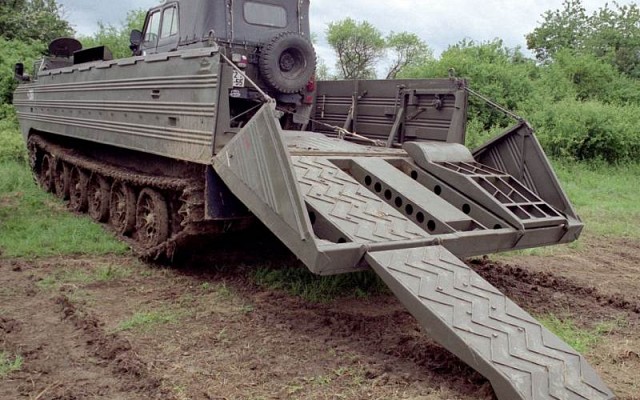
The rear ramp of a PTS-M (weaponsystems.net)
The most remarkable aspect it its rear hull ramp: The entire rear part is lowered via hydraulic arms, powered by the main engine forward. Two 6 meters ramps in two half-sections are then automatically lowered to complete the span to the ground and enabling any vehicle to climb. When close, it formed an internal open space about 1,30m high, which also participated to the vehicle's buoyancy. To avoid the vehicle's weight to crush the ramp, a blade-type cushion support is lowered with the same hydraulic system into the ground, also helping the PTS not being "pushed forward" when loading a vehicle, maintained firmly into the ground as artillery pieces.
Any load could be strapped inside thanks to numerous hooks and fixation systems in order to hold the payload firmly into place during the swim. With ten tons utility, a large variety of loads can be carried, from medium trucks to cars, supply palettes, and artillery pieces. The latter is extremely diverse and transforms the vehicle into an utility armaùent platform, tocket launcher, artillery, or AA vehicle.

PTS-M Driver's cab
Overall the cargo capacity, 5 t of cargo on land, 10 t in the water. However the carry capacity could be full up to 3 km in order to reach the water. The cargo area is typically loaded with a 5 t truck, but alternatively also 70 troops or 12 stretchers in medical evacuation, or 2 UAZ-469 vehicles or a Ural-4320 vehicle or an artillery system of caliber from 57 mm to 152 mm. Its payload can be extended by using the PKP floating trailer (see later). The Power to weight ratio is 16.7 hp/t empty and 10.7 hp/t at max load. It was tested able to have a ground clearance of 0.4 m, making it able to climb a Wall 0.65 m tall, gap a 2.5 m wide trench, and climb a 60% gradient unladen, 20% fully laden.
The beating hart of the PTS is its A-712P V12 V12 4-stroke water-cooled "flat" diesel coupled with a PTO propeller drive for swimming. It is located in the middle of the vehicle under the chassis for balance, exhausting on the sides through two vents "amidships". It was rated at 300 hp at 1.700 rpm with a fuel reserve of 820 L. Range is 300 km (190 mi) but it would not beat any speed record: 40 kph on land, 10 in the water. The lackluster performances of the initial vehicle rapidly led to design the much improved PTS-M, fitted with a V-54P V12 water-cooled diesel rated for 250 hp (190 kW) and later 350 hp. The latter now is able to travel at 42+ kph on land and 11+ in water.
Other data: Weight 17.8 t (PTS-M), 40,000 km without technical issue as tested, clearance 0.4 m, Track width 2.8 m, Ditch width 2.5 m, Wall climbing height 0.65 m, Minimum turning radius with trailer 10 m, Average fuel consumption per 100 km with a load of 5 tons 150 l, Average fuel consumption per hour of operation on water with a load of 10 tons 50 l, Fuel range: on land with a load of 5 tons 380 km Fuel range: on water with a load of 10 tons 12 h, Engine B-54 12 cylindres in V at 600° 350 hp, weight 17 t for Carrying capacity on the water and approaches to the obstacle: 5 t, Carrying capacity on land (on the march) and 10 t, Speed on a dirt road with a load of 5 tons 25-27 km/h, Speed on land with a load of 5 tons 42 km/h. Speed on water without load 11.5 km/h. water speed on the water with a load of 10 tons 10.6 km/h. Ascent and descent angles without load 30°, Ascent and descent angles with a load of 10 t 15°, Bank angles without load 20°, Roll angles with a load of 10 t 10°, Water entry and exit angles with a load of 10 tons 15°, Length 11.426 m Width 3.3 m Height 2.65 m.
PKP trailer
The PTS-M also has a companion vehicle, the PKP. It is a boat-like amphibious two-wheeled trailer. It had fold-out sponsons for extra stability on water and the ensemble is capable of accommodating an artillery tractor and its field gun (medium caliber) as well as the crew and equipment plus ammunition in the trailer, so allowing full transportation of a mobile land battery in one ferry.

PTS-2 with the PKP trailer in artillery carrier mode
PTS-2 ferrying a Kamaz 5-ton truck (vitaly kuzmin photo). Note the waterline red line, and pintle-mounted KPT LMG.
The PTS-2 is a further development of the PTS-M, but based around the newer MT-T tracked chassis. It is better suited to saltwater operations and official introduction is 1985, but with a production startign probably already in 1978. The MT-T chassis is essentially the same as the T-64 main battle tank, allowing for heavier payloads. I has folding ramp at the rear, and permanent pintle-mounted KPT LMG. It also had a more powerful 720 hp engine (T72), enabling a better payload capacity (12 tons, 75 troops) and mobility at 60 km/h and 12 km/h respectively. It is also compatible with the PKP amphibious trailer. No exports known, it only sees service with Russia and Ukraine.

PTS-2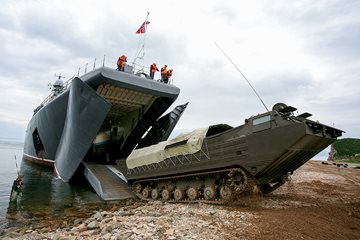 Photo (deagel.com): The supreme matriochka-like arrangement: A landing ship, carrying a PTS-4, carrying a vehicle, carrying personal and assets... In 2014, the Russian Defense Ministry intends to purchase an undetermined number of PTS-4s, undergoing acceptance trials in 2011. The main change is the adoption of a remotely operated 12.7 mm (0.50 in) machine gun. Under hood it was fitted with a multi-fuel engine, but this brings the total weight to 33 tons, with a payload of 12 tons on land and 18 tons on water, to adjust to new standard Russian trucks. Projected maximum top speed with its powerplant is 60 km/h (37 mph) and 15 km/h (9.3 mph) in water which is a notable improvement. Unlike its predecessors, it uses the T-80 main battle tank suspension components and now a fully enclosed cab offering a better protection against small arms fire and splinter. Production eventually started in 2014, but current status is unknown.
Photo (deagel.com): The supreme matriochka-like arrangement: A landing ship, carrying a PTS-4, carrying a vehicle, carrying personal and assets... In 2014, the Russian Defense Ministry intends to purchase an undetermined number of PTS-4s, undergoing acceptance trials in 2011. The main change is the adoption of a remotely operated 12.7 mm (0.50 in) machine gun. Under hood it was fitted with a multi-fuel engine, but this brings the total weight to 33 tons, with a payload of 12 tons on land and 18 tons on water, to adjust to new standard Russian trucks. Projected maximum top speed with its powerplant is 60 km/h (37 mph) and 15 km/h (9.3 mph) in water which is a notable improvement. Unlike its predecessors, it uses the T-80 main battle tank suspension components and now a fully enclosed cab offering a better protection against small arms fire and splinter. Production eventually started in 2014, but current status is unknown.
The PTS-4 was developed more for marine operations made ready to carry assets to enemy shore and developed by KBTM for the Russian Navy. Its biggest innovation is the remote 12.7mm weapon station. It was unveiled at the Russian Arms Expo (RAE) in September 2013.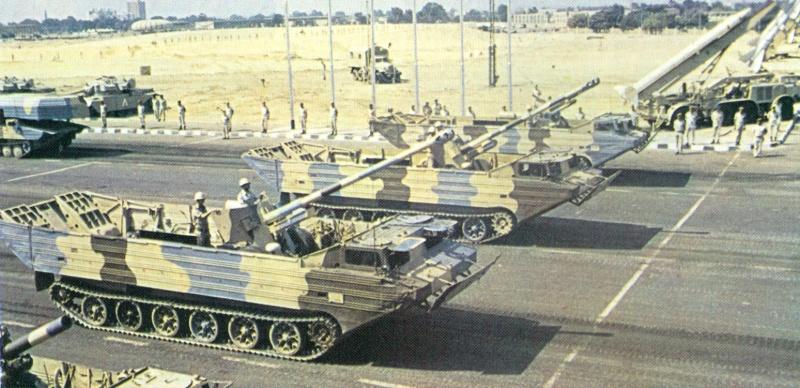
Egyptian PTS-M carrying an artillery piece in a parade, 1970s
The vehicle was widely used by USSR but also exported to Warsaw Pact Nations such as Yugoslavia (passed onto Serbia -still 12 active- and Republic of Srpska, Croatia -4-) Hungary (4), and Czechoslovakia (later the Czech Republic and Slovakia), Poland as well, which still operated 285 vehicle in the 2000s. East Germany also as shown in photos. As for successors state, Latvia had some, Georgia (unknown), Ukraine (same), as it was shown use by the Russian separatist forces in Donbass of the PTS-2.
Foreign exports included Egypt (as soon as available, seeing action in the 1973 war (operation Badr, the suez canal crossing), Iraq (unknown), Indonesia (no photo), Algeria (same), Syria (same), Uruguay (2 in 2016) but also Vietnam (proven by photos, unknown). The Indoesian vehicles saw action notably military operations in Aceh. Those in Syria during the civil war.
In Civilian service, the vehicle is now widely used by the rescue services of the Russian Ministry of Emergency Situations during rescue operations and liquidation of consequences in flood and flood zones.

Destroyed Iraqi PTS-M
International Institute for Strategic Studies (February 2016). The Military Balance 2016. Vol. 116. Routlegde.
weaponsystems.net
The PTS on Wikipedia
PTS-2 on weaponsystems.net
military-references.com
On military-today.com
On armyrecognition.com
On joint-forces.com
утк74.рф
eragun.org.ua
vezdehodlab.ru PTS-2
deagel.com
Free 3D model on sketchup
On wikimedia commons
On mhrfweb.makett.org
primeportal.net
On books.google.fr
On defence24.pl
On exarmyvehicles.com/
Design Development of "Ob'yekt 65"
The vehicle was designed from 1959 to replace the BAV-485, as "floating conveyor medium" to combine the best qualities of the T-54 tank and ATS-59 tractor in a waterproof hull to overcome water obstacles. So at the start it was designed as a riverine vehicle for specialized assault teams. The PTS-M transporter was to be able to carry personnel and cargo across rivers and it was to be equipped with a V-54p rated for HP 350.The vehicle was also to be used for transport tasks in wetlands. But primarily it was designed to quickly cross wide water obstacles with personnel and materiel, with a defined base load capacity of 5 tons on land and 10 tons on water. It was also defined as being capable of participating in shore amphibious operations, with sea waves up to 5 points. However in pratice that was risky as their powerplant was initially weak. Only the PTS-2 and PTS-4 today are more specialized in shore operations.
Ob'yekt 65 has been present in a number of sources and is unsubstantiated, not confirmed in official lists, even Russian. Other amphibians: Ob'yekt 270 (PT-76 amphibious tank)- Ob'yekt Ob'yekt 483 (137G2 amphibian with flamethrower), Ob'yekt 574 (ASU-57P), Ob'yekt 906B (PT-85), Ob'yekt 485A (BAV-A) and Ob'yekt 485B BAV-B amphibious trucks, Ob'yekt 490 (Amphibian vehicle complex 'Blue Bird'). ref
Design of the PTS

Before the PTS: K61 W amphibious transporter in parade.
The 17 tonnes PTS has a boxy open watertight hull, quite different than the BAV-485, which looked like a boat. The PTS is based on the chassis of the ATS-59 artillery tractor, but much longer and larger at 11.52 m (37 ft 10 in) long for 3.32 m (10 ft 11 in) in width, superior to the span of most truck, and still "only" 2.65 m (8 ft 8 in) tall, making for an elongated look.
It is leaning more towards a tracked barge in design, with angular front and rear, flat sides. This simplified construction, something designed to alleviate the rising cost compared to the truck-based BAV-485. This however reduced substantially its manoeuvrability when swimming, notably for turning and handling in the water (see later mobility).
The vehicle is really simple with a two-seat cabin at the front, widely separated by the transmission tunnel, the squared nose being ended by a swivel-axle trim vane, erected when needed to cope with choppy water. The engine and transmission are located below the seats, activating front drive sprockets. It's a "cab over" configuration. The 4/5 of the vehicle is occupied by its flatbed utility space.
For nagigation, the PTS was equipped with a gyro-semi-compass. The front cabin is the best protected part, notably sealed NBC with a filter-ventilation unit. A night vision device was provided as well as an infrared lamp and a R-113 or R-123 radio station.
Payload

The rear ramp of a PTS-M (weaponsystems.net)
The most remarkable aspect it its rear hull ramp: The entire rear part is lowered via hydraulic arms, powered by the main engine forward. Two 6 meters ramps in two half-sections are then automatically lowered to complete the span to the ground and enabling any vehicle to climb. When close, it formed an internal open space about 1,30m high, which also participated to the vehicle's buoyancy. To avoid the vehicle's weight to crush the ramp, a blade-type cushion support is lowered with the same hydraulic system into the ground, also helping the PTS not being "pushed forward" when loading a vehicle, maintained firmly into the ground as artillery pieces.
Any load could be strapped inside thanks to numerous hooks and fixation systems in order to hold the payload firmly into place during the swim. With ten tons utility, a large variety of loads can be carried, from medium trucks to cars, supply palettes, and artillery pieces. The latter is extremely diverse and transforms the vehicle into an utility armaùent platform, tocket launcher, artillery, or AA vehicle.

PTS-M Driver's cab
Overall the cargo capacity, 5 t of cargo on land, 10 t in the water. However the carry capacity could be full up to 3 km in order to reach the water. The cargo area is typically loaded with a 5 t truck, but alternatively also 70 troops or 12 stretchers in medical evacuation, or 2 UAZ-469 vehicles or a Ural-4320 vehicle or an artillery system of caliber from 57 mm to 152 mm. Its payload can be extended by using the PKP floating trailer (see later). The Power to weight ratio is 16.7 hp/t empty and 10.7 hp/t at max load. It was tested able to have a ground clearance of 0.4 m, making it able to climb a Wall 0.65 m tall, gap a 2.5 m wide trench, and climb a 60% gradient unladen, 20% fully laden.
Mobility
The train track of the PTS is composed of six road wheels per side, and in addition to the front drive sprocket, the chassis ends with rear idler sprocket, but there are no return rollers. Like the BAV 485, but unlike the DUKW, it has a rear loading ramp, but it is well refined and more heavy-duty. The crew is seated at the front than lifted over the side. Propulsion in water counts the action of twin propellers in tunnels to protect them from damage during land operations.The beating hart of the PTS is its A-712P V12 V12 4-stroke water-cooled "flat" diesel coupled with a PTO propeller drive for swimming. It is located in the middle of the vehicle under the chassis for balance, exhausting on the sides through two vents "amidships". It was rated at 300 hp at 1.700 rpm with a fuel reserve of 820 L. Range is 300 km (190 mi) but it would not beat any speed record: 40 kph on land, 10 in the water. The lackluster performances of the initial vehicle rapidly led to design the much improved PTS-M, fitted with a V-54P V12 water-cooled diesel rated for 250 hp (190 kW) and later 350 hp. The latter now is able to travel at 42+ kph on land and 11+ in water.
Other data: Weight 17.8 t (PTS-M), 40,000 km without technical issue as tested, clearance 0.4 m, Track width 2.8 m, Ditch width 2.5 m, Wall climbing height 0.65 m, Minimum turning radius with trailer 10 m, Average fuel consumption per 100 km with a load of 5 tons 150 l, Average fuel consumption per hour of operation on water with a load of 10 tons 50 l, Fuel range: on land with a load of 5 tons 380 km Fuel range: on water with a load of 10 tons 12 h, Engine B-54 12 cylindres in V at 600° 350 hp, weight 17 t for Carrying capacity on the water and approaches to the obstacle: 5 t, Carrying capacity on land (on the march) and 10 t, Speed on a dirt road with a load of 5 tons 25-27 km/h, Speed on land with a load of 5 tons 42 km/h. Speed on water without load 11.5 km/h. water speed on the water with a load of 10 tons 10.6 km/h. Ascent and descent angles without load 30°, Ascent and descent angles with a load of 10 t 15°, Bank angles without load 20°, Roll angles with a load of 10 t 10°, Water entry and exit angles with a load of 10 tons 15°, Length 11.426 m Width 3.3 m Height 2.65 m.
Protection
Although the PTS is not an offensive vehicle per se, its assault duties urged the adoption of a basic protection, two-sided: Classic armour, with 7mm RHA plating overall for the cabin and hull, providing basic protection against small arms fire and shrapnel. The cabin at first was open top but the final production model was unclosed, with interior lining, to be usable with a collective NBC system. There is no smoke discharger nor exhaust injection system for concealment. The cabin is dotted with four reinforced windows, but they can be doubled with bulletproof glass. In addition, these is Passive night vision for driver. There is also a provision for seven frames creating a tarpaulin type structure over the payload for weather protection (or water spray when swiming at sea).Armament
The PTS is normally unarmed, although there are two hatches above the crew members, and the commander on the left had access to a pintle-mounted LMG (Typically a PKT) and a projector for night operations. This system is present on the PTS-2 but it's unsure if it was provided to the PST-M as no photos shows these. The crew is armed with Kalashnikovs and pistols anyway. Given the nature of the payload, the vehicle can be turned as a weapon platform, to the payload limit for land operations (5 tons), like a howitzer.Options

PKP trailer
The PTS-M also has a companion vehicle, the PKP. It is a boat-like amphibious two-wheeled trailer. It had fold-out sponsons for extra stability on water and the ensemble is capable of accommodating an artillery tractor and its field gun (medium caliber) as well as the crew and equipment plus ammunition in the trailer, so allowing full transportation of a mobile land battery in one ferry.

PTS-2 with the PKP trailer in artillery carrier mode
Variants and evolution
PTS-M
Essentially the production of the PTS was cut short for engine upgrades. Only a few PTS were built initially, as a pre-production batch. The new 300 hp and later 350 hp engine enabled better performances. The name "PTS" is often applied to regular PTS-M vehicles, which currently forms the bulk of amphibious reserve, notably specialized riverine assault units. It had been supplanted in frontline units and in the Navy by the PTS-2 and largely exported. It remains in service in a number of countries, but those discarded found many uses in civilian service as well. The PTS-M differs also has a filter-ventilation system with cabin air heating, an awning with a tubular frame, searchlight, night vision device and R-123 radio station. The cargo area was increased from 18.5 m2 (7.1 x 2.6 m) to 20.54 m2 (7.9 x 2.6 m), with the same load capacity (10/5 tons). The marine equipment includes the same exhaust system extensions, folding wave deflector and extra glass protection, two powerful bilge pumps for 400/800 liters, two propellers and rudders to keep up at sea with waves up to 4-5 points. It is also equipped with a diesel heater for the cab and body in order to increase winter conditions use.PTS-2 (1976)

PTS-2 ferrying a Kamaz 5-ton truck (vitaly kuzmin photo). Note the waterline red line, and pintle-mounted KPT LMG.
The PTS-2 is a further development of the PTS-M, but based around the newer MT-T tracked chassis. It is better suited to saltwater operations and official introduction is 1985, but with a production startign probably already in 1978. The MT-T chassis is essentially the same as the T-64 main battle tank, allowing for heavier payloads. I has folding ramp at the rear, and permanent pintle-mounted KPT LMG. It also had a more powerful 720 hp engine (T72), enabling a better payload capacity (12 tons, 75 troops) and mobility at 60 km/h and 12 km/h respectively. It is also compatible with the PKP amphibious trailer. No exports known, it only sees service with Russia and Ukraine.

PTS-2
PTS-3 (1985)
The development of the PTS-2 was carried out by the Luhansk locomotive factory in 1973 and it was introduced from 1976, under main designers were S.P. Filonow and V.P. Koldow. The minor PTS-3 was developed as a successor in the 1980s but only produced in small numbers. In 2009, the Russian Ministry of Defense decided to replace the PTS-2 with the PTS-4 instead, which had a far better mobility and payload. It was probably based on the same T-64 chassis and better engine, or both the engine and chassis of the T80 MBT.PTS-4
 Photo (deagel.com): The supreme matriochka-like arrangement: A landing ship, carrying a PTS-4, carrying a vehicle, carrying personal and assets... In 2014, the Russian Defense Ministry intends to purchase an undetermined number of PTS-4s, undergoing acceptance trials in 2011. The main change is the adoption of a remotely operated 12.7 mm (0.50 in) machine gun. Under hood it was fitted with a multi-fuel engine, but this brings the total weight to 33 tons, with a payload of 12 tons on land and 18 tons on water, to adjust to new standard Russian trucks. Projected maximum top speed with its powerplant is 60 km/h (37 mph) and 15 km/h (9.3 mph) in water which is a notable improvement. Unlike its predecessors, it uses the T-80 main battle tank suspension components and now a fully enclosed cab offering a better protection against small arms fire and splinter. Production eventually started in 2014, but current status is unknown.
Photo (deagel.com): The supreme matriochka-like arrangement: A landing ship, carrying a PTS-4, carrying a vehicle, carrying personal and assets... In 2014, the Russian Defense Ministry intends to purchase an undetermined number of PTS-4s, undergoing acceptance trials in 2011. The main change is the adoption of a remotely operated 12.7 mm (0.50 in) machine gun. Under hood it was fitted with a multi-fuel engine, but this brings the total weight to 33 tons, with a payload of 12 tons on land and 18 tons on water, to adjust to new standard Russian trucks. Projected maximum top speed with its powerplant is 60 km/h (37 mph) and 15 km/h (9.3 mph) in water which is a notable improvement. Unlike its predecessors, it uses the T-80 main battle tank suspension components and now a fully enclosed cab offering a better protection against small arms fire and splinter. Production eventually started in 2014, but current status is unknown.
The PTS-4 was developed more for marine operations made ready to carry assets to enemy shore and developed by KBTM for the Russian Navy. Its biggest innovation is the remote 12.7mm weapon station. It was unveiled at the Russian Arms Expo (RAE) in September 2013.
Exports and Combat use

Egyptian PTS-M carrying an artillery piece in a parade, 1970s
The vehicle was widely used by USSR but also exported to Warsaw Pact Nations such as Yugoslavia (passed onto Serbia -still 12 active- and Republic of Srpska, Croatia -4-) Hungary (4), and Czechoslovakia (later the Czech Republic and Slovakia), Poland as well, which still operated 285 vehicle in the 2000s. East Germany also as shown in photos. As for successors state, Latvia had some, Georgia (unknown), Ukraine (same), as it was shown use by the Russian separatist forces in Donbass of the PTS-2.
Foreign exports included Egypt (as soon as available, seeing action in the 1973 war (operation Badr, the suez canal crossing), Iraq (unknown), Indonesia (no photo), Algeria (same), Syria (same), Uruguay (2 in 2016) but also Vietnam (proven by photos, unknown). The Indoesian vehicles saw action notably military operations in Aceh. Those in Syria during the civil war.
In Civilian service, the vehicle is now widely used by the rescue services of the Russian Ministry of Emergency Situations during rescue operations and liquidation of consequences in flood and flood zones.

Destroyed Iraqi PTS-M
T-55 specifications | |
| Dimensions (L-w-h) | 6.27 (9 m oa) x 3.15 x 2.40 m (20.6 x 10.4 x 7.1 ft) |
| Total weight, battle ready | 36 tons – 36.4 long tonnes (72,000 lbs) |
| Crew | 4 (commander, driver, gunner, loader) |
| Propulsion | V-55 12-cyl diesel, 581 hp (433 kW) |
| Top speed | 55 km/h (34 mph) |
| Suspensions | Torsion bars with hydraulic arms |
| Range (with extra tanks) | 501 (960 l) to 600 km (311 to 370 mi) |
| Armament | Main: 1 x 100 mm D-10T2G or D-10T2 rifled (3.94 in) Sec: 1 x 12.7 mm (0.5 in) DSHK AA (back in 1972) Sec: 1-2x 7.62 mm (0.3 in) PKT & SGMT machine guns |
| Armor | Frontal glacis 120 mm (4.7 in), sides 80 (3.15 in), rear 45 (1.77 in), turret front 200 (7.87 in), roof 30 (1.18 in), bottom 20 mm (0.79 in) |
| Production (USSR only) | Approx. 27,500 |
Sources
Hogg, Ian V., and Weeks, John. The Illustrated Encyclopedia of Military Vehicles, p. 309, "PTS Tracked Amphibian". London: Hamblyn Publishing Group, 1980.International Institute for Strategic Studies (February 2016). The Military Balance 2016. Vol. 116. Routlegde.
weaponsystems.net
The PTS on Wikipedia
PTS-2 on weaponsystems.net
military-references.com
On military-today.com
On armyrecognition.com
On joint-forces.com
утк74.рф
eragun.org.ua
vezdehodlab.ru PTS-2
deagel.com
Free 3D model on sketchup
On wikimedia commons
On mhrfweb.makett.org
primeportal.net
On books.google.fr
On defence24.pl
On exarmyvehicles.com/
Illustration

Egyptian PTS-M

Iraqi PTS-M

Polish PTS-M

East German PTS-M

PTS-M, 61st Guards Brigade Northern Flotilla

Czech PTS
Gallery
Polish PTS-M Museum

PTS-M in an exhibition, 2015
PTS-M VS4

PTS-2 at race of Heroes

Serbian PTS-1

Serbian engineers unit's PTS-M

Hungarian PTS-M

Rear of the PTS-M

Russian PTS-M

Polish PTS at Miedzyrzecz Fortification
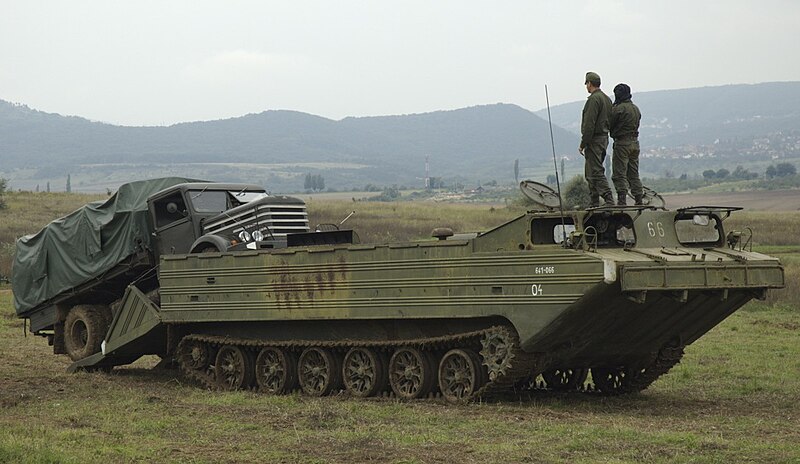
Hungarian Vehicle loading a truck

Polish PTS-M

Old PTS-M trim vane down - pinterest
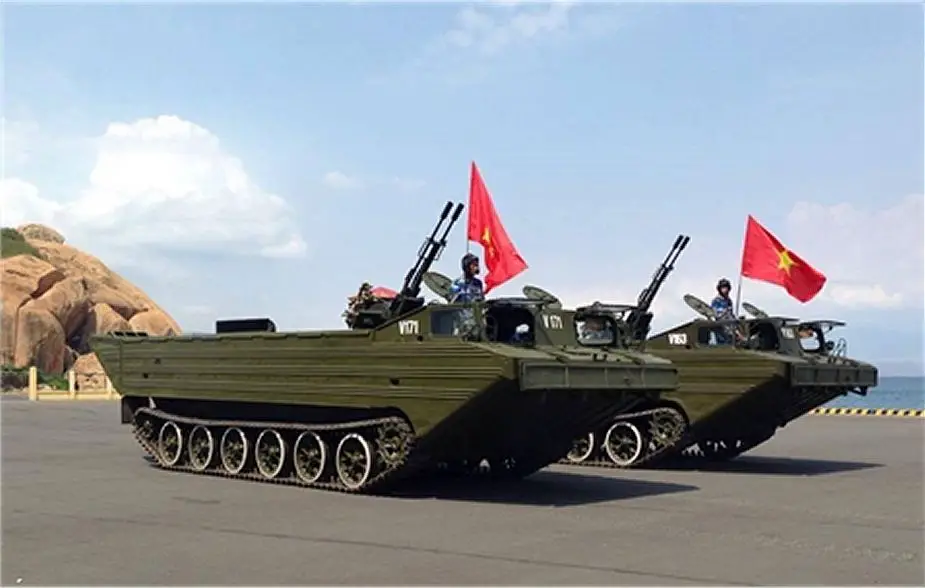
Vietnamese PTS-M with SU-23-2 Mounts
Polish PTS-M
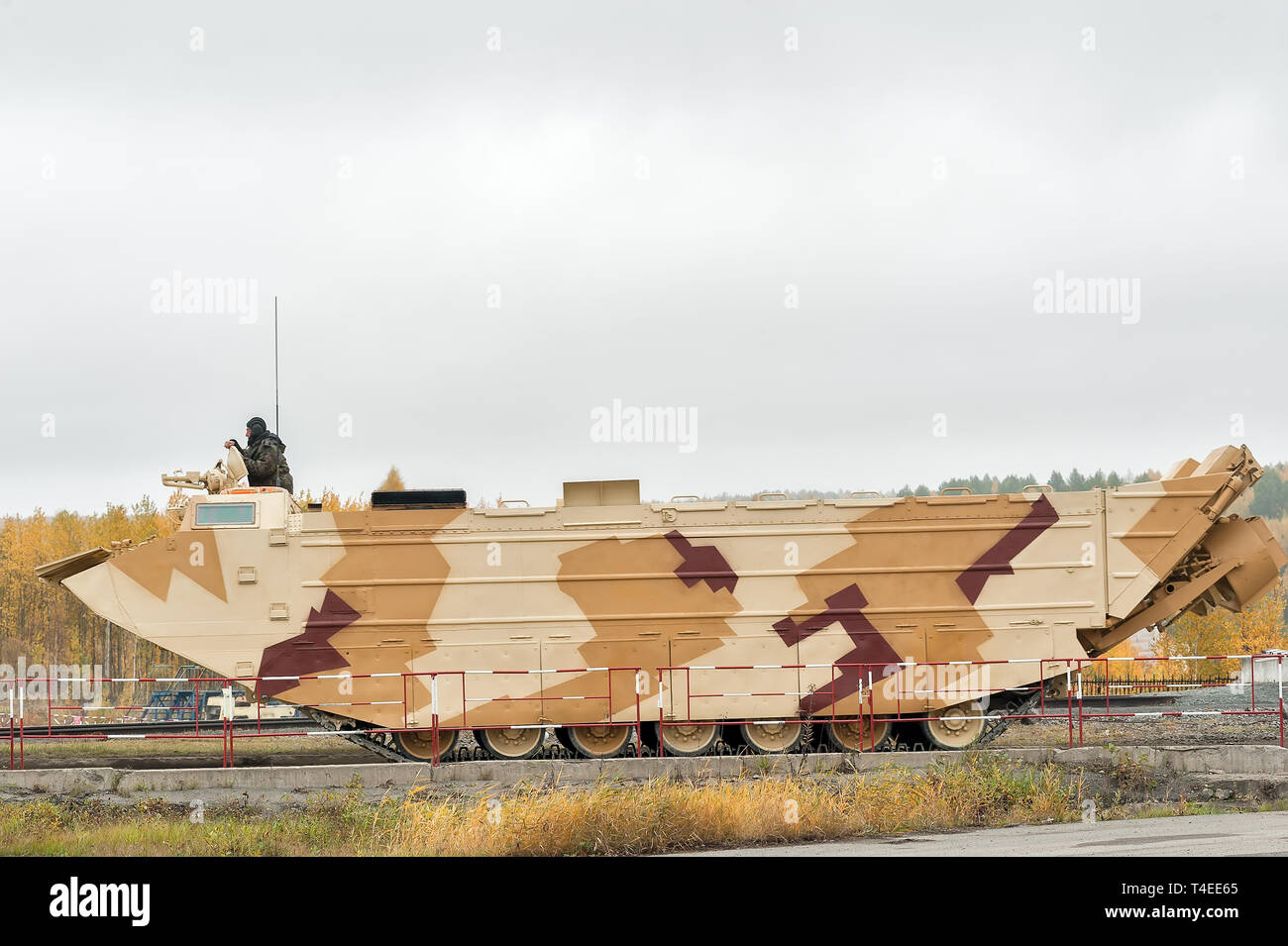
PTS-4 at Nizhniy Tagil, Russia, September 27. 2013 for RAE-2013 exhibition
Videos

Cold War Tanks


































Cold war tanks posters

Cold War Main Battle Tanks

Cold War Soviet Army

